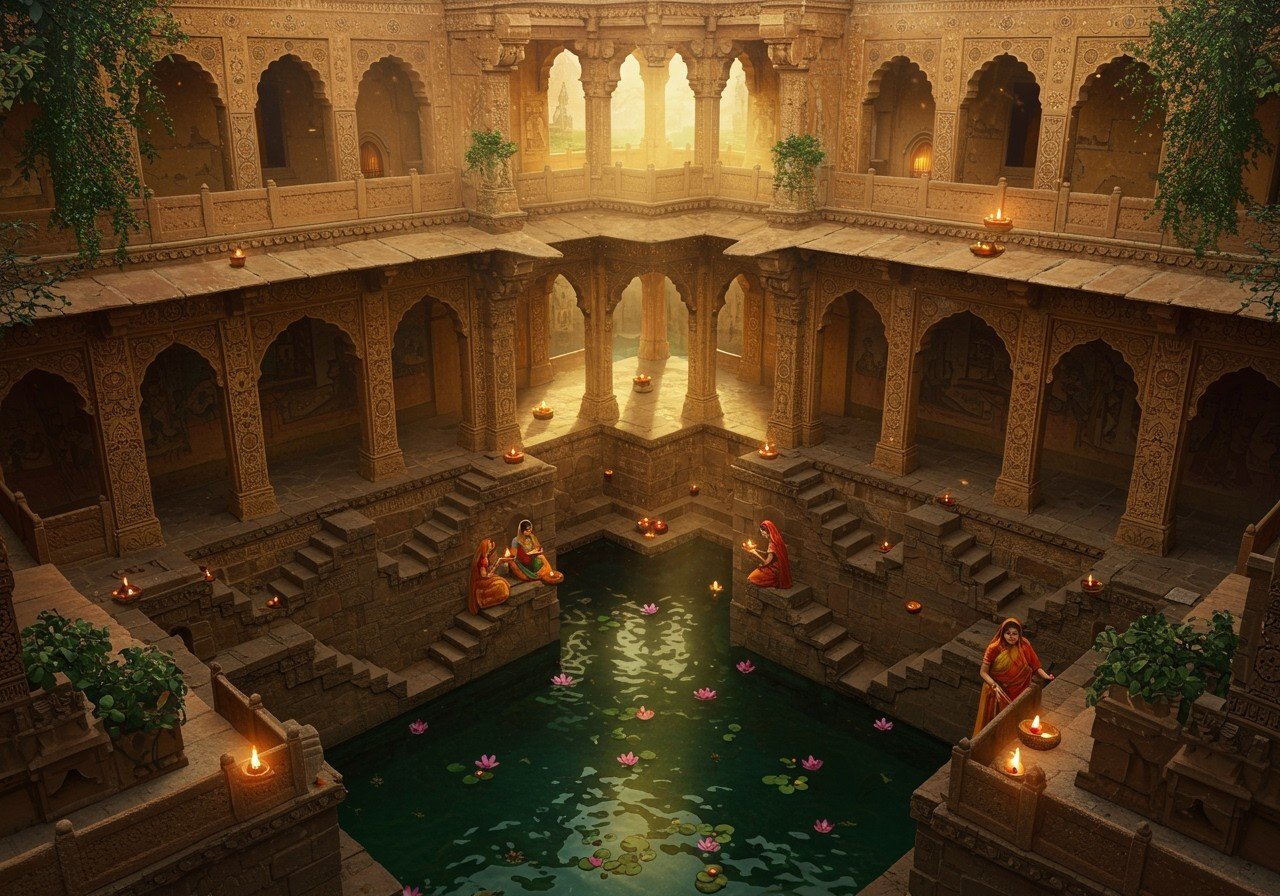
Stepwells, also known as baolis, baoris, or vavs, are ancient water storage systems integral to India’s architectural and cultural heritage. These marvels are not merely functional; they possess deep spiritual and social meaning. This article delves into the intricate relationship between stepwells and spirituality, exploring their architectural brilliance, cultural implications, and community roles.
The Architecture of Stepwells
Stepwells showcase the ingenuity of ancient Indian architecture. Designed for water storage and respite from the heat, they often incorporate sacred geometry principles, with intricate carvings depicting deities, mythological scenes, and daily life. The blending of Islamic and Hindu artistic elements is often visible, reflecting India’s rich and diverse history.
- Rani ki Vav in Gujarat: This UNESCO World Heritage site is renowned for its ornate carvings and sculptures, a testament to the Solanki dynasty’s architectural prowess. It’s a prime example of the Maru-Gurjara architectural style, showcasing intricate details and a multi-storied layout.
- Agrasen ki Baoli in Delhi: This stepwell, shrouded in mystery and local legends, is notable for its geometric precision and symmetrical design. It’s a protected monument under the Archaeological Survey of India and continues to fascinate visitors with its historical aura.
Spiritual Significance of Stepwells
Beyond their utility, stepwells held profound spiritual meaning. Water, a symbol of purity, life, and renewal in Indian culture, played a central role in these structures. The descent into the earth to reach the water symbolized a spiritual journey, a cleansing of the soul.
- Ritualistic Bathing: Many stepwells were integrated into temple complexes or built near sacred sites, facilitating ritual purification before worship. This practice underscores the importance of water in Hindu ceremonies.
- Meditation Spaces: The tranquil environment within a stepwell, away from the hustle and bustle of daily life, created an ideal space for contemplation and meditation, fostering a connection with the divine. The echoing sounds and cool air further enhanced the meditative atmosphere.
- Chand Baori in Rajasthan: This visually stunning stepwell, with its seemingly endless steps, exemplifies the spiritual significance of these structures. It’s an architectural masterpiece that embodies the sacred geometry principles often found in stepwells.
Stepwells and Temples
The connection between stepwells and temples is undeniable. Many stepwells were integral parts of temple complexes, serving as spaces for purification rituals before entering the main shrine. They reflect the cosmological beliefs and spiritual aspirations of the time.
- Adalaj Stepwell in Gujarat: This stepwell showcases a beautiful fusion of Hindu and Islamic architectural elements, reflecting the region’s diverse cultural influences. Its intricate carvings and unique design make it a popular destination.
- Purification Rituals: The act of descending into the stepwell and bathing in its waters was seen as a way to cleanse oneself both physically and spiritually before approaching the deity in the temple. This ritual emphasized the importance of purity in worship.
Subtle Cultural Aspects of Stepwells
Stepwells served as social hubs, bringing together people from all walks of life. They hosted cultural performances, festivals, and gatherings, fostering a sense of community.
- Traditional Festivals: Stepwells became venues for celebrating festivals and religious events, strengthening community bonds and reinforcing cultural traditions. These gatherings often involved music, dance, and storytelling.
- Literature and Art: Stepwells frequently appear in folklore, literature, and art, highlighting their cultural importance and enduring legacy. They represent a unique aspect of Indian heritage.
- Female Empowerment: Women played a vital role in the upkeep and usage of stepwells, often managing the water resources and organizing community activities around these structures. This showcases their significant contribution to social life.
Stepwells and Local Communities
Stepwells were essential to local communities, providing water for drinking, irrigation, and daily needs. Their construction often involved communal efforts and royal patronage, showcasing collaborative spirit and sustainable practices.
- Self-Sustainability: Stepwells often incorporated rainwater harvesting techniques, demonstrating ancient water conservation practices. This ensured a reliable water source even during dry periods.
- Communal Efforts: The construction and maintenance of stepwells involved the participation of local communities and royal benefactors, reflecting a collective responsibility for water management.
- Revival Efforts: Today, communities and organizations are working to restore and preserve these ancient structures, recognizing their historical, architectural, and ecological value. These efforts aim to revitalize these forgotten treasures.
Poojn.in: Supporting Your Spiritual Journey
Poojn.in, India’s leading online store for cultural goods and services, offers a wide range of products to enhance your spiritual practices related to stepwells and temples. Explore our collection of puja items, including Shiva Lingams, Radha Krishna Bigrahas, and more, to create a sacred space in your home.
Conclusion
Stepwells are far more than just ancient water systems. They are testaments to India’s rich cultural and spiritual heritage, architectural brilliance, and community life. Preserving these structures connects us to our roots and the timeless wisdom of our ancestors. Stepwells continue to inspire with their beauty, functionality, and the profound connection between humanity, nature, and the divine.


